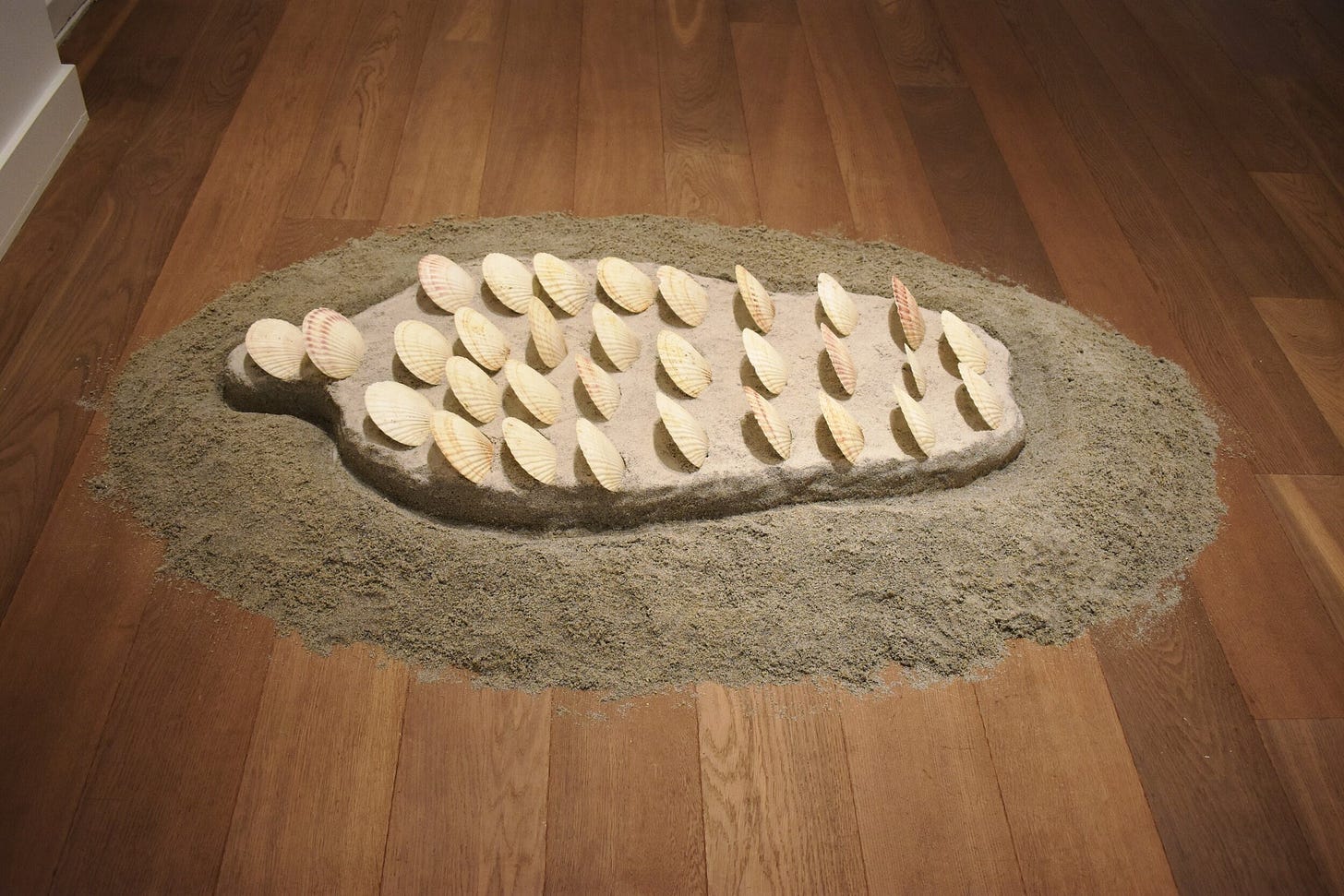Hi friends!
Have you heard of the Stanford marshmallow experiment?
It was started in the late 1960s, to test strategies on delayed gratification. The studies led researchers to believe that the successful delay of gratification depended on “cognitive avoidance or suppression” of the expected treats during the waiting period. It’s easier to not-have things you don’t see.
This is one of the reasons Diana Winston and Donald Rothberg once held a workshop on gratitude and greed at a Bed, Bath and Beyond. It is so easy to want things.
Many meditation teachers will recommend stores and lines are common places for everyday practice. Send metta to the people in the “faster” lines you didn’t choose. Practice breathing meditation. Is this not, however, another form of delayed gratification, since the goal is to get out of the store?
This is a reflection on patience, the next Perfection in the series. I'll explore three aspects: patience beyond delay, patience as presence, and patience in practice through art and nature.
Light Hive offers essays on applied mindfulness for complex identities, the polycrisis, and the power of play. Subscribe for contemporary takes on Buddhist wisdom, filtered through the lens of a recovering academic and queer, transracial adoptee.
Patience
Patience is presence.
I opened with the marshmallow experiment because so many people tie patience to uncomfortable durations of time and, later, the gratification of the wait being over.
This connection between patience and reward is so deeply embedded in our cultural understanding that it helped shape modern capitalism itself. Time is money, right? (See, if you’d like, the work of Max Weber or Rey Chow.)
But what happens when there's no guaranteed reward at the end? What does patience mean when facing climate change, chronic illness, or other situations where “waiting it out” isn't an option?
Another wrench: patience isn’t needed when you’re on vacation. Like morality, renunciation, discernment, and so on—patience can only really arise when meeting the discomfort of near or far opposites (immorality, clinging, confusion).
So what is it and how do we do it?
Pema Chödrön offers
Patience means to sit still and with the vulnerability of the situation, let yourself feel the soft spot in your heart and let your mind remain open and not follow the momentum of aggression.
Try to remember small steps matter; “practice” is the refrain because perfection is not the goal. We don't need to sit with overwhelming discomfort all at once.
Sometimes patience means allowing ourselves to approach difficult experiences in small doses, backing off when needed, and building our capacity to be present.
Let me offer a slightly different frame.
Instead of patience as enduring the now for a future reward, what if it was deep presence with what is? Here, patience is only accessible amid anxious impulses or ruminations about the past. Patience is embedding, encasing ourselves, in the reality of the moment—the joy of it, the fear of it, the love of it.
The people in our lives, the events of our lives, aren’t forever. Nothing is forever. Knowing this and still believing in qualities like compassion and equanimity is patience.
When my cat was first diagnosed with kidney disease, I came across a line that said something like, “We were never meant to keep, just to keep watch.” (I apologize to the original author—my googling did not turn you up.)
We don’t get to own things like time or, I’d argue, cats. We do get to experience. We do get to keep watch.
At the same time, we do not need to be passive. Patience doesn't mean idly accepting harmful conditions. When we're responsive rather than reactive, we can act with greater clarity toward making the social, political, ecological, and systemic change we want or need. 100% clarity isn’t attainable, but responsiveness does open up our options.
(I want to honor that this administration’s behavior has created cycles of reactivity across sectors. You are normal if you’ve been reactive. Unfortunately, today’s normalcy often excludes patience.)
This balance between patience, action, and change isn't limited to political contexts. Performance artists, like Ana Mendieta, deeply understand impermanence. It could be said Mendieta’s life was marked by displacement and a subsequent search for environmental safety and belonging.
Creating in temporary conditions, imagining in the low tide.
The piece below is a (mildly revised) sample from last week’s Notes From the Inflection Point, my Substack with Lou Baker on interfacing with and articulating climate emotions.
What the Tides Can Teach Us
The tides come and go regardless of our wishes or seawalls. Each of us are in and of time, but we do not own it. We only own our actions.
Imagine, if you can, an afternoon walk through the forest, just after a light rain. The smell of wet grass, lichen. The slight stickiness of mud. The sound of the early birds claiming first back, mixing with rain still trickling through the leaves.
This connection with land, whether through a walk or re-wilding, is so important. Artist and shaman Maria Mison recently told me the land beneath our feet informs our daily life practice.
People are a little bit more intuitive, more fluid when the land is at peace. We absorb energies via the land, right? So sometimes when people feel disoriented and not belonging somewhere, it's because their energies haven't been dug down.
She describes spirituality in the Philippines as "soupy" and "syncretic." Her spirituality exists in the liminal space between colonizer and colonized, creating something entirely new from the fragments.
The Cuban-American artist Ana Mendieta dug down, into, through, beyond. Forcefully displaced as a child, she embodied what it meant to wear the world like a loose garment. Her silhouettes in the sand, mud, grass marked the intersection between body and place.
Being and absence. Impermanence.

Her sand sculptures evidenced dialogue among indigenous memories, colonized landscapes, her presence. All with the explicit knowledge the tide would still come.
Digging down: recognizing ourselves in the fleeting sculptures of soil and sand.

This, too, is me. And Ana. And Maria. Our fragility is our most honest quality. The way we hold our innate vulnerability is a testament to who and how we are.
We are stronger together.
We become the care we practice.
We cannot force the warming winds to change.
But even in concrete circumstances, we can honor our interdependence, proclaiming our relation to smell of pine sap, birdsong, and even the rain.
If you liked this, consider checking out:
Takeaway Practice
Instead of distracting yourself or focusing on the future reward, dive fully into the present moment.
For some of us, especially those carrying past wounds, this turning toward can be gradual rather than diving in. Notice what you can. Keep noticing.
I always start with the body. What does impatience feel like to you? Do you notice tightness in your chest? Subtle (or not-so-subtle) agitation? Is it dull? Does your mind go blank?
Can you practice "keeping watch" rather than "keeping" that discomfort?
I tend to put my hand over my heart to hold myself whether sitting, standing, or lying down.
If there’s space, I like to spread myself out on the floor and imagine myself sinking into it with each exhale.
If noticing these sensations becomes overwhelming, it's okay to shift your attention elsewhere for a while. Consider focusing on the part of you that’s giving rise to impatience…the part that wants to protect and guide you.
Creative Coalition: May 4th, 3-6 PT
Join Creative Coalition to practice with patience, play, and mindful writing.
Can a house demonstrate patience? Using Carrion Comfort/ Wes Frank's This Old House, we'll tell the story of a house as its inhabitants change over time.
Each month, we begin with a meditation, a compressed intro to mindful play, community guidelines and individual intentions for practice, and then we play.
This event will be hosted as a writing group, rather than dialogic play. We’ll share the same prompts and craft our own neighborhood, with breaks to read aloud and reflect.
You’ll leave with practical feedback and support on how to practice mindfulness amid change and uncertainty, while reaching for imagination and wonder, in a supportive group setting.
Base Rate: $20
Light Hive Readers may use code: Hive50 (50% off)
Paid subscribers get this one for free! I’ll give you a code in the chat.
No one is turned away for lack of funds. If the registration fee is cost-prohibitive, please email for the link.
Bio
Logan Juliano, PhD (they/them) is a queer, transracial adoptee who blends rigor and lived experience to create brave spaces where mindfulness meets playful exploration. Through Light Hive and as co-editor of Notes from the Inflection Point, they help readers find grounding practices amid ecological and social uncertainty. Logan holds a PhD in Performance Studies and are neither a mental health provider, nor an authorized teacher in any Buddhist lineage. (They also just completed First Aid/CPR/AED training!)








Thanks for this. I’ve been working on my patience once I realized that impatience is one of my default resting states. Being aware of my relationship with time has made all the difference- not sure if you’ve read “Four Thousand Weeks” but it’s a great book about that.